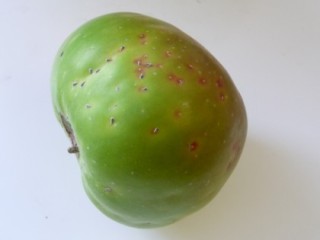
Mussel scale has become an increasingly important and common pest of apple in recent years. It sometimes attacks pear.
Several other scale insects including pear scale, oyster scale and nut scale also occur locally, mainly on cider apples which are infrequently sprayed with insecticides. Mussel scale is readily distinguished from the others as it is the only one that is mussel-shaped whereas pear scale and oyster scale are roughly circular.
Wild hosts such as hawthorn may act as a source of infestation.
The main damage is caused by the presence of mussel scales on the surface of fruits at harvest. The contamination is superficial but may downgrade the fruit.
Very heavy infestations on the bark may debilitate the tree and there may be some contamination of the foliage with honeydew.
The life cycle is limited to one generation per year. The timing of egg hatch and dispersal on the tree varies between years depending on spring temperatures.
Correct timing of insecticide sprays for control is important and should be determined by regular monitoring.
- Weekly examination of mother scales and the surface of the bark on dry days though the critical period is required.
- Alternatively, the branches of infested trees may be furnished with sticky bands made from double sided sticky tape and the numbers of crawlers captured counted and the bands refreshed each week.
- By this method it is possible to ascertain when approximately 80-90% of scales have emerged.
- This is the critical time for application of first sprays. A temperature-based forecasting model can give useful back-up.
Control
- Research in AHDB Horticulture Project TF 180 demonstrated that control is best achieved with sprays of acetamiprid (Gazelle) applied from 50% crawler emergence or later, followed by a second treatment two weeks after that, particularly where heavy infestations occur.
- Where infestations are really heavy, 3 applications may be required, remembering not to exceed the maximum permitted for any one product.
- It was also found that the use of an adjuvant (Break Thru) with acetamiprid achieved the same degree of control as one application on its own.
- If a single spray of one of these materials is to be used against light infestations, it is best applied at about 80-90% crawler emergence.
- This product is most effective against emerged migrating crawlers and first and second stage scales that have recently settled at their feeding sites. It has little effect on scales that have not emerged from under their mother scale.
- As the product only has effective action for a week or two, applications in the later stages of the emergence cycle catch the maximum proportion of the population at the susceptible stage.
- A full approval for spirotetramat (Batavia) on apples for the control of sucking insect pests will offer some control of mussel scale, but growers may prefer to reserve its use for difficult to control pests such as woolly aphid or rosy apple aphid. It must be applied after flowering and works best when pests are moving from brown wood to green tissue. It will prevent population build-up but does not offer pest ‘knockdown’.
- A recent EAMU for Flipper (fatty acids) has increased the available options should growers wish to reserve other insecticides for control of pests later in the season. Although recommended for control of aphids, mites and blossom weevil, it may offer incidental control of mussel scale crawlers when appled for other pests. It is known to complement the use of Batavia as it provides quick ‘knockdown’.
- Synthetic pyrethroids are also partially effective but they should not be used because they are harmful to the orchard predatory mite Typhlodromus pyri and many other important natural enemies.
Insecticides approved for use on apple which are recommended for control of scale insects or offer incidental control when applied to control other pests
| Choice of insecticides - efficacy factors | |||||
|---|---|---|---|---|---|
| Active ingredient | Trade name (examples) | Class | Selectivity | Approved for control of | Safety for Typhs |
| acetamiprid | Gazelle | neonicotinoid | broad-spectrum, systemic | Aphids | safe |
| deltamethrin | Decis Forte etc. | pyrethroid | broad spectrum | Aphids, apple sucker, capsids, codling & tortrix moths, sawfly | harmful |
| fatty acids | Flipper (EAMU 3419/19) | bioinsecticide | broad spectrum | Aphids, blossom weevil, two-spotted spider mite | unspecified but generally safe in IPDM programmes |
| spirotetramat | Batavia | tetramic acid derivative | selective | Sucking insect pests | unclassified |
| Choice of insecticides - safety factors | |||||||
|---|---|---|---|---|---|---|---|
| Hazards | Harvest interval(days) | Max. no. sprays | Buffer zone width (m) | ||||
| Anticholin-Esterase? | Humans | Fish &aquatic life | Bees | ||||
| acetamirpid | no | u | t | u | 14 | 2 | 20 |
| deltamethrin | no | h, i | ed | d | 7 | u | 18 |
| fatty acids | no | h, i | h | u | 0 | 8 | 20 |
| spirotetramat | no | h, i | t | d | Start of ripening | 2 | 10 |
| h=harmful, i=irritant, d=dangerous, ed=extremely dangerous, t = toxic, c=closed cab required for air assisted sprayers, u=uncategorised/unclassified/unspecified | |||||||
Control in organic orchards
- Priority should be given to cultural control methods and fostering natural enemies.
- High volume sprays of fatty acids may be used as described under ‘Chemical control’ above. The importance of correct timing of sprays is stressed. Fatty acids is permitted for use in organic production systems, but prior approval must be given by certification bodies before application.
